Project Management ( Part 3 )
Managing Risk
Risk Management Process
Risk Defined:
- An uncertain event or condition that if it occurs, has a positive or negative effect on project objectives.
- No amount of planning can overcome or control risk.
Risk Management Defined:
An attempt to recognize and manage potential and unforeseen trouble spots that may occur when the project is implemented.
- What can go wrong (risk event)
- How to minimize the risk event’s impact (consequences)
- What can be done before an event occurs (anticipation)
- What to do when an event occurs (contingency plans)
Benefits of Risk Management
- A proactive rather than reactive approach
- Reduces surprises and negative consequences
- Prepares the project manager to take appropriate action
- Provides better control over the future
- Improves chances of reaching project objectives on time, within budget, and of meeting required performance.
Risk Identification
- Generate a list of all the possible risks that could affect the project through brainstorming and other problem identifying techniques.
- Focus on the events that could produce consequences, not on project objectives.
- Use risk breakdown structure (RBS) in conjunction with work breakdown structure (WBS) to identify and analyze risks.
- Identify the macro risks first then specific areas can be checked.
- Use risk profile (a list of questions) to address traditional areas of uncertainty on a project.
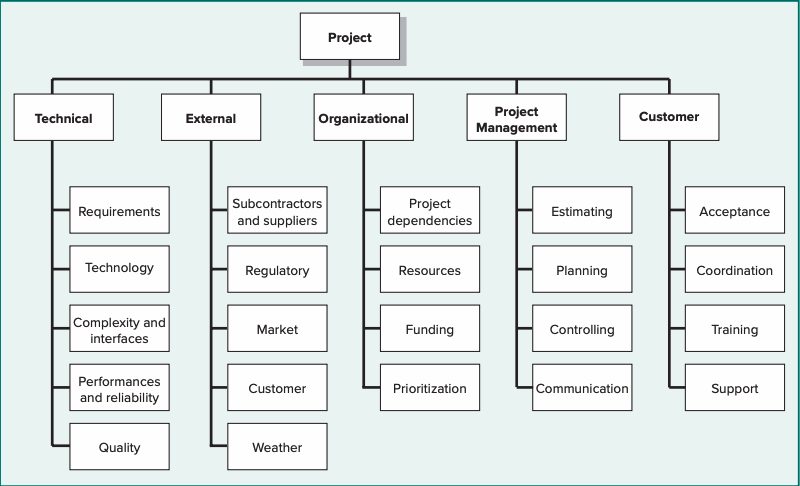
Risk Assessment
- Scenario analysis assesses the significance of each risk event in terms of probability and impact.
- Risk assessment form evaluates the severity, probability of risk events and its detection difficulty.
- Risk severity matrix prioritizes which risks to address.
- Failure Mode and Effects Analysis (FMEA) extends the risk severity matrix by including ease of detection in the equation:
Risk Value = Impact x Probability x Detection
- Probability analysis uses statistical techniques in assessing project risk.
- Decision trees, net present value (NPV), program evaluation and review technique (PERT), PERT simulation
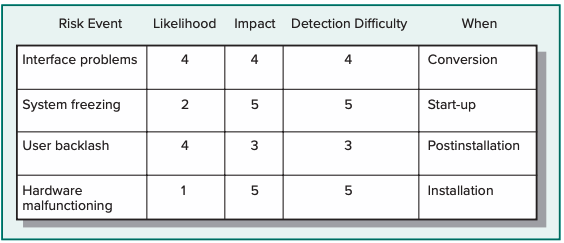

Risk Response Development
- Mitigating Risk
- Reducing the likelihood that the event will occur
- Reducing the impact that the adverse event would have on the project
- Avoiding Risk
- Changing the project plan to eliminate the risk or condition
- Transferring Risk
- Passing risk to another party
- Examples: Fixed-price contracts, insurance, Build-Own-Operate-Transfer (BOOT) provisions
- Passing risk to another party
- Escalating Risk
- Notifying the appropriate people within the organization of the threat
- Retaining Risk
- Making a conscious decision to accept the risk of an event occurring
Contingency Planning
- Contingency Plan Defined
- Is an alternative plan that will be used if a possible foreseen risk event becomes a reality.
- Is a plan of action that will reduce or mitigate the negative impact of the risk event.
- Is not a part of the initial implementation plan and only goes into effect after the risk is recognized.
- Risks of the absence of a contingency plan
- Cause a manager to delay or postpone the decision to implement a remedy
- Lead to panic and acceptance of the first remedy suggested
- Make the decision making under pressure which can be dangerous and costly
Risk and Contingency Planning
- Technical Risks
- Backup strategies if chosen technology fails
- Assess whether technical uncertainties can be resolved
- Schedule Risks
- Expedite or “crash” the project to get it back on track
- Schedule activities in parallel or use start-to-start lag relationships
- Use the best people for high-risk tasks
- Cost Risks
- Review price to avoid the trap of using one lump sum to cover price risks
- Funding Risks
- Evaluate the risk of reductions in funding—a cut in the project
Opportunity Management
An opportunity is an event that can have positive impact on project objectives.
- Exploit
- Seek to eliminate the uncertainty associated with an opportunity to ensure that it definitely happens
- Share
- Allocate some or all of the ownership of an opportunity to another party who is best able to capture the opportunity for the benefit of the project
- Enhance
- Take action to increase the probability and/or the positive impact of an opportunity
- Escalate
- Notify the appropriate people within the organization of the opportunity
- Accept
- Be willing to take advantage of the opportunity if it occurs, but not taking action to pursue it
Contingency Funding and Time Buffers
- Contingency Funds
- Contingency reserves—cover identified risks
- Management reserves—cover unidentified risks
- Time Buffers: Are amounts of time used to cushion against potential delays in the project
- Add to activities with severe risks
- Add to merge activities that are prone to delays
- Add to noncritical activities to reduce the likelihood that they will create another critical path
- Add to activities that require scare resources
Risk Response Control
- Risk Register: descriptions, category, probability of occurring, impact, responses, contingency plans, owners, and current status
- Risk Control
- Executing the risk response strategy
- Monitoring triggering events
- Initiating contingency plans
- Watching for new risks
- Establishing a Change Management System
- Monitoring, tracking, and reporting risk
- Fostering an open organization environment
- Repeating risk identification/assessment exercises
- Assigning and documenting responsibility for managing risk
Change Control Management
- Sources of Change
- Project scope changes
- Implementation of contingency plans
- Improvement changes
- Change Management Systems
- Identify proposed changes.
- List expected effects of proposed change(s) on schedule and budget.
- Review, evaluate, and approve or disapprove changes formally.
- Negotiate and resolve conflicts of change, conditions, and cost.
- Communicate changes to the parties affected.
- Assign responsibility for implementing change.
- Adjust the master schedule and budget.
- Track all changes that are to be implemented

Benefits of Change Control Systems
- Inconsequential changes are discouraged by the formal process.
- Costs of changes are maintained in a log.
- Integrity of the WBS and performance measures is maintained.
- Allocation and use of contingency and management reserves are tracked.
- Responsibility for implementation is clarified.
- Effect of changes is visible to all parties involved.
- Implementation of change is monitored.
- Scope changes will be quickly reflected in baseline and performance measures
Scheduling Resources and Costs
Overview of the Resource Scheduling Problem
Resources and Priorities
- Project network times are not a schedule until resources have been assigned.
- There are always more project proposals than there are available resources.
- The project priority team will add a new project only if resources are available.
- Cost estimates are not a budget until they have been time-phased.
- Once resource assignments have been finalized, you are able to develop a baseline budget schedule for the project.
The Resource Scheduling Problem
- Resource Smoothing: delaying non-critical activities (using slack). increase resource utilization.
- Resource-Constrained Scheduling: some activities must be delayed
Types of Resource Constraints
Technical or Logical Constraints: Are related to the networked sequence in which project activities must occur.
Resource Constraints:
- Occur when the absence, shortage, or unique interrelationship and interaction characteristics of resources require a particular sequencing of project activities.
- Note that the resource dependency takes priority over the technological dependency but does not violate the technological dependency
Types of Resources Constraints:
- People
- Materials
- Equipment
Classification of a Scheduling Problem
- Time-Constrained Project: resources can be added
- Resource-Constrained Project: If the resources are inadequate, it will be acceptable to delay the project.
Resource Allocation Methods
- Limiting Assumptions
- Splitting activities will not be allowed.
- Level of resources used for an activity cannot be changed.
- Risk Assumptions
- Activities with the most slack pose the least risk.
- Reduction of flexibility does not increase risk.
- The nature of an activity (easy, complex) doesn’t increase risk.
Time-Constrained Projects
- Must be completed by an imposed date.
- Focus on resource utilization.
- Require use of resource smoothing techniques that balance demand for a resource
Smoothing Resource Techniques: Delay noncritical activities by using positive slack to reduce peak demand and fill in the valleys for the resources without delaying the entire project
- Goals
- Reduce the peak of demand for the resource
- Reduce the number of resources over the life of the project
- Minimize the fluctuation in resource demand
- Downside
- Loss of flexibility that occurs from reducing slack
- Creates more critical activities and/or near-critical activities because of slack reduction

Resource-Constrained Projects
priority rules:
- Minimum slack: will not inflence others
- Smallest (least) duration: release resource early
- Lowest activity identification number: logically
parallel method: when the resources needed exceed the resources available, retains activities first by the priority rules.
The Impacts of Resource-Constrained Scheduling:
- Reduces slack; reduce flexibility
- Increases the number of critical and near-critical activities
- Increases scheduling complexity because resource constraints are added to technical constraints
- May make the traditional critical path no longer meaningful
- Can break the sequence and leave the network with a set of disjointed critical activities
- May cause parallel activities to become sequential
- Can change activities from critical to noncritical
Computer Demonstration of ResourceConstrained Scheduling
MS project
Splitting Activities
Splitting Tasks
- Is a scheduling technique used to get a better project schedule and/or to increase resource utilization.
- Involves interrupting the work and sending the resource to another activity for a period of time and then having the resource resume work on the original activity.
- Can be useful if the work involved does not include large start-up or shut-down costs.
- Is considered a major reason why projects fail to meet schedule.
Benefits of Scheduling Resources
- Leaves time for considering reasonable alternatives
- Cost-time tradeoffs
- Changes in priorities
- Provides the information needed to prepare time-phased work package budgets with dates
- To gauge the impact of unforeseen events
- To assess how much flexibility over certain resources
Assigning Project Work
- Reasons why we should not always assign the best people the most difficult tasks
- Best people: resent to the fact that they are always given the toughest assignments
- Less experienced participants: resent to the fact that they are never given the opportunity to expand their skill/knowledge base
- Factors to be considered in deciding who should work together
- Minimize unnecessary tension; complement each other
- Experience: veterans team up with new hires
- Future needs: have people work together early on so that they can become familiar with each other
Multiproject Resource Schedules
Problems:
- Delays in one project create delays for other projects
- Inefficient resource utilization: Different schedules and requirements by multiple projects create the peaks and valleys in overall resource demands
- Resource bottlenecks: Shortages of critical resources required by multiple projects cause delays and schedule extensions.
Approach:
- Create project offices or departments to oversee the scheduling of resources across multiple projects
- Use a project priority queuing system—first come, first served for resources
- Treat individual projects as part of one big project and adapt the scheduling heuristics to this “mega project”
- Utilize project management software to prioritize resource allocation
- Outsource projects to reduce the number of projects managing internally
- Hire temporary workers to expedite certain activities that are falling behind schedule
- Contract project work during peak periods when there are insufficient internal resources to meet the demands of all project
Using the Resource Schedule to Develop a Project Cost Baseline
- Why a Time-Phased Budget Baseline Is Needed
- To determine if the project is on, ahead, or behind schedule and over or under its budgeted costs
- To assess how much work has been accomplished for the allocated money spent—the project cost baseline (planned value, PV)
- Creating a Time-Phased Budget
- Assign each work package to one responsible person or department and deliverable
- Compare planned schedule and costs using an integrative system called earned value
- Generate cash flow statements and resource usage schedules
Reducing Project Duration
Rationale for Reducing Project Duration
Crash: shortening the duration of an activity or a project beyond when it normally can be done.
Reasons for attempting to reduce the duration of a project are:
- Time-to-market pressures
- Unforeseen delays
- Incentive contracts (bonuses for early completion)
- Imposed deadlines and contract commitments
- Overhead costs
- Pressure to reassign resources to other projects
Options for Accelerating Project Completion
Resources Are Not Constrained
- Add resources
- Outsource project work
- Schedule overtime
- Establish a core project team
- Do it twice—fast and correctly
Resources Are Constrained
- Improve project team efficiency
- Fast tracking
- Use critical-chain management
- Reduce project scope
- Compromise quality
Project Cost-Duration Graph
Explanation of Project Costs
- Project Indirect Costs
- Are costs that cannot be associated with any particular work package or activity ( overhead supervision, administration, consultants, and interest ).
- Are costs that vary directly with time.
- Project Direct Costs
- Are costs that assigned directly to a work package and activity ( labor, materials, equipment, subcontractors ).
- Represent normal costs (low-cost, efficient methods for a normal time).
Constructing a Project Cost-Duration Graph
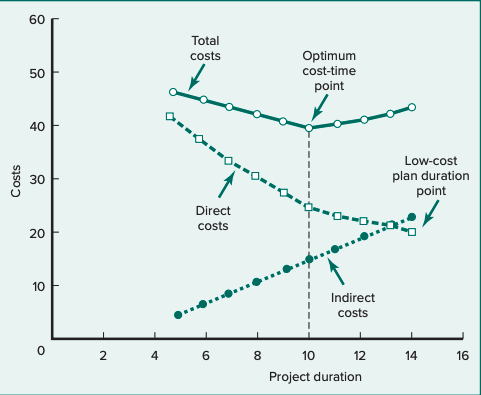
Determining the Activities to Shorten
Which activities to shorten?
Look for critical activities that can be shortened with the smallest increase in cost per unit of time.
Assumptions:
- The cost-time relationship is linear.
- Normal time assumes low-cost, efficient methods to complete the activity.
- Crash time represents a limit—the greatest time reduction possible under realistic conditions.
- Slope represents cost per unit of time.
- All accelerations must occur within the normal and crash times.

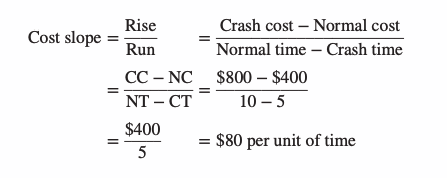
Cost-Duration Trade-off Example
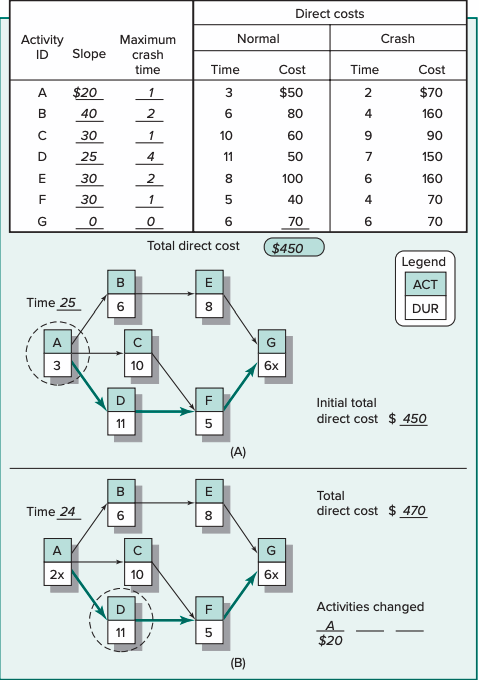
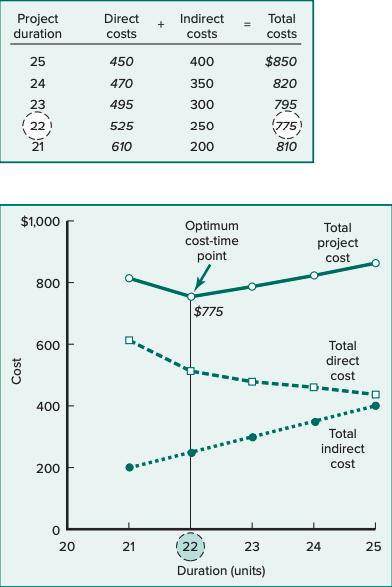
What If Cost, Not Time, Is the Issue?
Commonly used options for cutting costs are:
- Reduce project scope
- Have owner take on more responsibility
- Outsource project activities or even the entire project
- Brainstorm cost savings options
Being an Effective Project Manage
Managing versus Leading a Project
Managing—coping with complexity
- Formulate plans and objectives
- Monitor results
- Take corrective action
- Expedite activities
- Solve technical problems
- Serve as peacemaker
- Make tradeoffs among time, costs, and project scope
Leading—coping with change
- Recognize the need to change to keep the project on track
- Initiate change
- Provide direction and motivation
- Innovate and adapt as necessary
- Integrate assigned resources
Engaging Project Stakeholders
Stakeholders are people and organizations that are actively involved in the project or whose interests may be positively or negatively affected by the project.
Project Management Maxims:
- You can’t do it all and get it all done.
- Projects usually involve a vast web of relationships.
- Hands-on work is not the same as leading.
- More pressure and more involvement can reduce your effectiveness as a leader.
- What’s important to you likely isn’t as important to someone else.
- Different groups have different stakes (responsibilities, agendas, and priorities) in the outcome of a project.
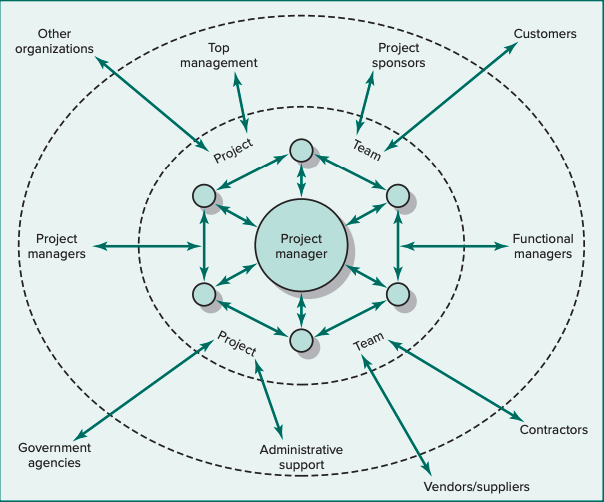
Influence as Exchange
You scratch my back, I’ll scratch yours
Commonly Traded Organizational Currencies
Task-related currencies
- Resources Lending or giving money, budget increases, personnel, etc.
- Assistance Helping with existing projects or undertaking unwanted tasks.
- Cooperation Giving task support, providing quicker response time, or aiding implementation.
- Information Providing organizational as well as technical knowledge.
Position-related currencies
- Advancement Giving a task or assignment that can result in promotion.
- Recognition Acknowledging effort, accomplishments, or abilities.
- Visibility Providing a chance to be known by higher-ups or significant others in the organization.
- Network/contacts Providing opportunities for linking with others.
Inspiration-related currencies
- Vision Being involved in a task that has larger significance for the unit, organization, customer, or society.
- Excellence Having a chance to do important things really well.
- Ethical correctness Doing what is “right” by a higher standard than efficiency.
Relationship-related currencies
- Acceptance Providing closeness and friendship.
- Personal support Giving personal and emotional backing.
- Understanding Listening to others’ concerns and issues.
Personal-related currencies
- Challenge/learning Sharing tasks that increase skills and abilities.
- Ownership/involvement Letting others have ownership and influence.
- Gratitude Expressing appreciation.
Social Network Building
Mapping Stakeholder Dependencies
- Project team’s perspective
- Whose cooperation will we need?
- Whose agreement or approval will we need?
- Whose opposition would keep us from accomplishing the project?
- Stakeholder’s perspective
- What differences exist between the team and the people on whom the team depends?
- How do the stakeholders view the project?
- What is the current status of the relationship the team has with the stakeholders?
- What sources of influence does the team have relative to the stakeholders on whom the team depends?
Management by Wandering Around (MBWA)
- Management by Wandering Around (MBWA) involves managers spending the majority of their time outside their offices in order to have face-to-face interactions with employees building cooperative
relationships. - Relationships should be built before they are needed.
- Characteristics of Effective Project Managers
- Initiate contact with key stakeholders to keep abreast of developments
- Anticipate potential problems
- Provide encouragement
- Reinforce the objectives and vision of the project
- Intervene to resolve conflicts and prevent stalemates from occurring
Managing Upward Relations
Project success is strongly affected by the degree to which a project has the support of top management. Top management must:
- Provide an appropriate budget
- Be responsive to unexpected needs
- Send a clear signal to others in the organization of the importance of the project and the need to cooperate
- Rescind unreasonable demand
- Provide additional resources
- Recognize the accomplishments of team members
Ethics and Project Management
Ethical Dilemmas—situations where it is difficult to determine whether conduct is right or wrong
- Padding of cost and time estimations
- Exaggerating pay-offs of project proposals
- Falsely assuring customers that everything is on track
- Being pressured to alter status reports
- Falsifying cost accounts
- Compromising safety standards to accelerate progress
- Approving shoddy work
Building Trust: The Key to Exercising Influence
- Trust
- Is an elusive concept.
- Is a function of character (personal motives) and competence (skills necessary to realize motives).
- Is sustained through frequent face-to-face contact.
- The core of highly effective people is a character ethic.
- Consistency — more predictable
- Openness — more receptive to others
- A sense of purpose — what is best for the organization and the project
Qualities of an Effective Project Manager Summary
- Effective communication skills
- Systems thinking
- Personal integrity
- Proactivity
- High emotional intelligence (EQ)
- General business perspective
- Effective time management
- Optimism
Contradictions of Project Management
- Innovate and maintain stability
- See the big picture while getting their hands dirty
- Encourage individuals but stress the team
- Be hands-off/hands-on
- Be flexible but firm
- Manage team versus organizational loyalties
Managing Project Teams
The Five-Stage Team Development Model

Situational Factors Affecting Team Development
Conditions Favoring Development of High-Performing Project Teams
- There are 10 or fewer members per team.
- Members volunteer to serve on the project team.
- Members serve on the project from beginning to end.
- Members are assigned to the project full time.
- Members are part of an organization culture that fosters cooperation and trust.
- Members report solely to the project manager.
- All relevant functional areas are represented on the team.
- The project involves a compelling objective.
- Members are located within conversational distance of each other.
Building High-Performance Project Teams
Considerations that need to be factored into the recruitment process
- Problem-solving ability
- Availability
- Technological expertise
- Credibility
- Political connections
- Ambition, initiative, and energy
- Familiarity
Conducting project meeting
- The first project team meeting—project kick-off meeting
- Establishing ground rules
- Planning decisions
- Tracking decisions
- Managing change decisions
- Relationship decisions
- Managing subsequent project meetings
Establishing Team Norms
- Confidentiality is maintained; no information is shared outside the team unless all agree to it.
- It is acceptable to be in trouble, but it is not acceptable to surprise others. Tell others immediately when deadlines or milestones will not be reached.
- There is zero tolerance for bulling a way through a problem or an issue.
- Agree to disagree, but when a decision has been made, regardless of personal feelings, move forward.
- Respect outsiders, and do not flaunt one’s position on the project team.
- Hard work does not get in the way of having fun.
Establishing a Team Identity
- Effective use of meetings
- Co-location of team members
- Creation of project name
- Get the team to build or do something together early on
- Team rituals
Managing Project Reward Systems
- The reward system encourages team performance and extra effort.
- Most project managers advocate the use of group rewards.
- To increase the value of rewards, rewards need to have lasting significance.
- Some project managers have to use negative reinforcement to motivate project performance.
- There are times when we need to reward individual performance. Examples of this kind of rewards include:
- Letter of recommendation
- Public recognition for outstanding work
- Job assignments
- Flexibility
Group Decision-Making Process:
- Identifying problems
- Generating alternatives
- Reaching a decision
- Following up
Managing Conflict within the Project
- Encouraging Functional Conflict: obtaining a deeper understanding of the issues and coming up with the best decisions possible
Managing Dysfunctional Conflict
- Mediate the conflict
- Arbitrate the conflict
- Control the conflict
- Accept the conflict
- Eliminate the conflict
Managing Virtual Project Teams
Two biggest challenges involved in managing a virtual project team are
- Developing trust
- Hold a face-to-face meeting at the beginning and orchestrate the exchange of social information
- Set clear roles for each team member
- Form teams with people who have already worked effectively together on projects, if possible
- Developing effective patterns of communication
- Don’t let team members vanish
- Establish a code of conduct to avoid delays
- Establish clear norms and protocols for surfacing assumptions and conflicts
- Use electronic video technology to verify work
- Share the pain
Project Team Pitfalls
- Groupthink
- Illusion of invulnerability
- Whitewash of critical thinking
- Negative stereotypes of outsiders
- Direct pressure
- Bureaucratic bypass syndrome
- Team spirit becomes team infatuation
Project Management ( Part 3 )
https://kongchenglc.github.io/blog/2024/11/14/About-Project-Management-Part-3/